Abstract
The new concept of Connected and Automated Vehicles (CAVs) necessitates a need to review the approach of managing the existing civil infrastructure system (highways, bridges, sign structures, etc.). This paper provides a basic introduction to the CAV concept, assesses the infrastructure requirements for CAVs, and identifies the appropriateness of the existing infrastructure, and needs, in terms of the condition assessment and deterioration modeling. With focus on the Vehicle-to-Infrastructure (V2I) requirements for CAVs, the main elements required on the infrastructure are the Roadside Units (RSUs), which are primarily for communication; they are similar to non-structural transportation assets, such as traffic signals, signs, etc. The ongoing pertinent efforts of agencies and the private industry are reviewed, including the V2I Deployment Coalition (American Association of State Transportation Officials (AASHTO), the Institute of Transportation Engineers (ITE), and the Intelligent Transportation Society of America (ITS America)). Current methods of transportation asset management, particularly, of non-structural elements, are also reviewed. Two reliability-based models were developed and demonstrated for the deterioration of RSUs, including the age replacement model, and a combined survivor function considering the vulnerability of the CAV elements to natural hazards, such as the hurricanes. The paper also discusses the implications of the CAV technology on traffic models, particularly, how it affects user costs’ computations.
1. Introduction
The U.S. Department of Transportation (Vehicle-to-Infrastructure)’s Connected Vehicle (CV) Program provides a simple definition of the CV concept as a technology that enables cars, buses, trucks, trains, roads, and other infrastructure, and our smartphones and other devices to communicate with each other [1]. It would be possible for cars to use short-range radio signals to communicate with each other (Vehicle-to-Vehicle, or V2V, concept) to assess each other’s location on the roadway, as well as information on potentially dangerous situations, such as red light violations or collision from other cars swerving into their lanes. The car drivers would also be able to receive pertinent information from sensors or units mounted the roadway infrastructure (Vehicle-to-Infrastructure concept, or V2I) to alert, for instance, the time to green lights at signalized intersections.
There are vehicles that contain automated driving functions, such as automatic emergency braking, adaptive cruise control, and the ability to scan the roadway environment and make decisions. The most advanced of these automated vehicles (AVs) are sometimes referred to as autonomous vehicles, when they do not rely at all on any human intervention for control. These AVs can navigate the existing roadways without the need to communicate with other vehicles or the roadway infrastructure. The National Highway Traffic Safety Administration (NHTSA) [2] used the term Automated Driving Systems (ADSs) to describe automated or self-driving vehicles. But it should be noted that these AVs can be configured to also perform as CVs. Thus, this technology is sometimes termed CVs/AVs or connected and automated vehicles (CAVs).
The CAV technology can be best explained as consisting of three systems: intelligent transportation systems (ITS), AV systems, and CV systems. Each of these systems is depicted in Figure 1, showing the various components and specific examples of applications [3]. Many of the detailed elements shown in Figure 1 are informative to the general understanding of the CAV concept but not very relevant to the focus of this paper.
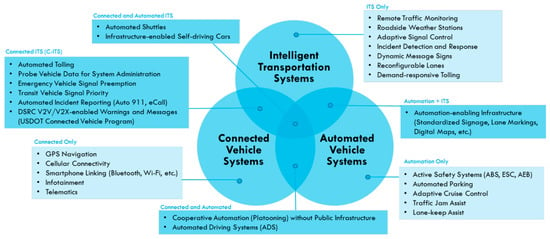
Figure 1.
Relating intelligent transportation systems (ITS), automated vehicle (AV) systems, and connected vehicle (CV) systems [3]. USDOT = U.S. Department of Transportation; DSRC = Dedicated Short Range Communications; V2V = Vehicle-to-Vehicle; V2X = Vehicle-to-Everything; GPS = Global Positioning System; ABS = Anti-Lock Brake Systems; ESC = Electronic Stability Control; AEB = Automated Emergency Braking.
The five levels of vehicle automation for CAVs as defined by the NHTSA and the Society of Automotive Engineers (SAE) International, include the following [4]:
- No Automation (Level 0): The driver is in complete and sole control of the primary vehicle controls—brakes, steering, throttle, and motive power—at all times.
- Function-Specific Automation (Level 1): Automation at this level involves one or more specific control functions. Examples include electronic stability control or pre-charged brakes, where the vehicle automatically assists with braking to enable the driver to retain control of the vehicle or stop faster than possible if acting alone.
- Combined Function Automation (Level 2): This level involves automation of at least two primary control functions designed to work in unison to relieve the driver of control of those functions. An example of combined functions enabling a Level 2 system is adaptive cruise control in combination with lane centering.
- Limited Self-Driving Automation (Level 3): Vehicles at this level of automation enable the driver to cede full control of all safety-critical functions under certain traffic or environmental conditions to rely on the vehicle to monitor changes in those conditions requiring transition back to driver control. The driver is expected to be available for occasional control, but with sufficient transition time. The Google car is an example of limited self-driving automation.
- Full Self-Driving Automation (Level 4): The vehicle is designed to perform all safety-critical driving functions and monitor roadway conditions for an entire trip. Such a design anticipates that the driver will provide destination or navigation input but is not expected to be available for control at any time during the trip. This includes both occupied and unoccupied vehicles. The SAE definitions further breaks the NHTSA’s Level 4 into SAE’s Level 4 (high automation) and Level 5 (full automation), as shown in Figure 2.
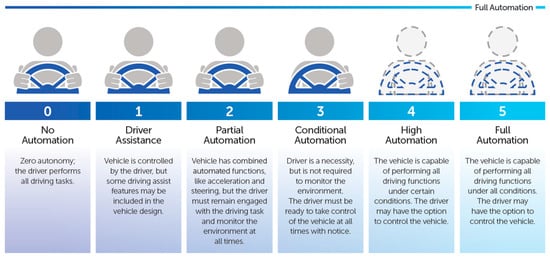 Figure 2. Society of Automotive Engineers (SAE) automation levels [2].
Figure 2. Society of Automotive Engineers (SAE) automation levels [2].
Chang [5] described some aspects of the CV technology, specifically, the V2I technology, and Dedicated Short Range Communications (DSRC) Roadside Units (RSUs), including a mention of the standards and interoperable components that satisfy Infrastructure Owners and Operators’ (IOOs) requirements. The Federal Communications Commission (FCC) originally defined the RSU as a DSRC transceiver that is mounted along a road or pedestrian passageway, and it may also be mounted on a vehicle or hand-carried. Based on the work by Battelle, Chang [5] also showed the overall V2I hub consisting of the following components: Traffic Signal Controller; RSU; Global Positioning System (GPS); Transportation Management Center (TMC); Map Message; Signal Phase and Timing (SPAT); and Curve Speed Warning (CSW), as well as the need for infrastructure sensor systems for position correction and local weather data.
Some of the benefits of the CAV technology are expected to include the following: dramatic reduction in roadway crashes because vehicles can navigate better through the sensing and communication to avoid hazards around them; improvement in vehicle mobility due to the availability of substantially more up-to-date, accurate, and comprehensive information on travel conditions and options; and reduction in the environmental impacts of vehicles and travel because the vehicles can plan trips better and enhance fuel efficiency by avoiding unnecessary stops [6]. Waldrop [7] indicated that 90% of all accidents are due to human error and that an adoption of the CAV technology is expected to improve safety drastically on the roadways. It has also been estimated that the CAV technology could reduce congestion and improve safety by eliminating or mitigating the severity of up to 80 percent of non-impaired roadway crashes, including those at intersections or while changing lanes [8]. Despite all these anticipated benefits of the CAV technology, there are also some expected drawbacks. AVs will cost more than the conventional vehicles, and there are risks of crashes associated with the AV’s possible errors in analyzing and reacting to real life situations [9]. Other shortcomings of the AVs include risks, such as a failure of the AV’s computer system and cybersecurity vulnerability [9]. But it is expected that as the CAV technology matures, these shortcomings will be reduced and eliminated, based, for example, on the risk management methods being employed by the AV manufacturers [10].
Based on these prior discussions, roadways and the bridge structures, including culverts, will be the existing civil infrastructure of major interest in the context of this paper. AVs by themselves do not really imply any need for a modification of the existing infrastructure, but the CVs will need it, primarily because of the V2I communication requirements. It should also be noted that, despite the claim by AV manufacturers of no need for the V2I, safety will definitely be enhanced with use of both technologies. With the anticipation that, eventually, AVs and CVs will operate together, where AVs will be able to communicate with other vehicles (V2V), as well as the infrastructure (V2I), and then it can be concluded that CAVs will impact the infrastructure.
2. Automation of the Infrastructure
Cheon [11] and Zhang [12] presented the evolvement of the concept of a fully-automated highway system and the definition of system levels as it affects the infrastructure. Cheon [8] identified three levels of how the infrastructure may influence some aspects of the automation: support, manage, or control of the infrastructure, and listed needed activities, such as local position keeping, lane changing, obstruction avoidance, and flow control. Based on these influence and other factors, Zhang [12] discussed a framework for assessing infrastructure needs for CAVs by presenting infrastructure requirements in terms of the levels of automation; it was shown that not many physical entities are required to be installed on the roadways or bridges, other than the RSUs, and possibly the magnetic nails/reflective striping, which may be necessary for lane keeping.
3. Infrastructure Requirements for CAVs
The V2I operation is demonstrated in Figure 3, showing the associated infrastructure. In this case, the RSU is mounted on the traffic light arm, where it receives information from the traffic signal controller, and transmits to the on-board equipment in the vehicle. Other aspects of the V2I include a traffic signal controller, a backhaul, a local or state back office, and an On-Board Unit (OBUs) or equipment inside the vehicles (Figure 3). More detailed features of the RSU and a traffic signal controller are shown in Figure 4. It should also be noted that as components of the Intelligent Transportation Systems (ITS) on roadways, there are elements embedded in the pavements, such as the induction loop detectors (Figure 5), which typically communicate the vehicle’s presence to the traffic signal controllers. For V2I applications, some RSUs, coupled with sensors, may also be mounted on bridges for the following purposes: CSW; oversize vehicle warning; and reduced speed or work zone warning.
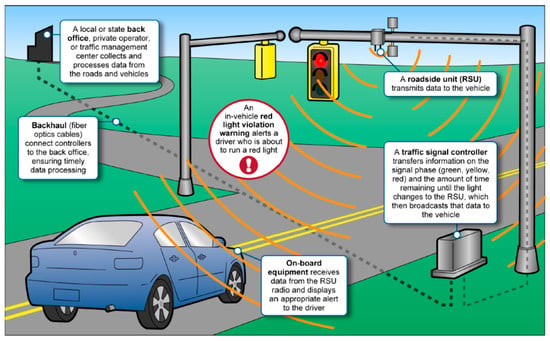
Figure 3.
An illustration of the Vehicle-to-Infrastructure (V2I) operation [13].
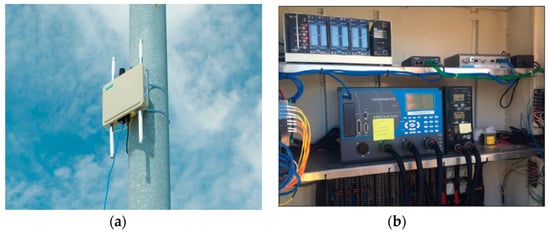
Figure 4.
Connected and Automated Vehicle (CAV) elements on the infrastructure: (a) Roadside Unit (RSU) [14]; (b) traffic signal controller [15].
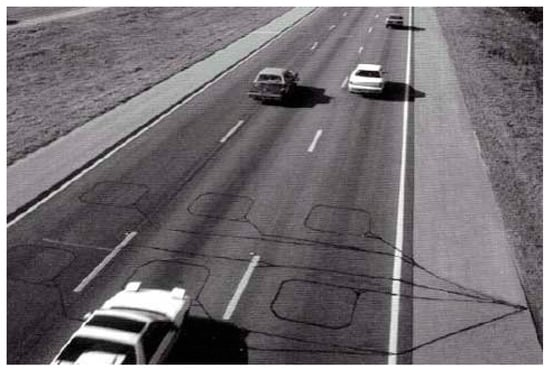
Figure 5.
Induction loop detectors at freeway location on the roadway [16].
Barbaresso and Johnson [15] reported that the primary emphasis of the CV program thus far has been on V2V safety and that most public agencies are not sure about the role of infrastructure. The results of a survey of five public agencies on the issues of infrastructure, specifically, for the V2I implementation are shown in Table 1. All the five agencies appear to have similar infrastructure needs for the CV technology implementation, except for a few cases, such as applications to freight and transit vehicles, with the former being more relevant for the state agencies and the latter for the smaller agencies. Agency needs are also shown to be different for emergency vehicle applications and the use of CSW. The public agencies were concerned about the robustness of the currently available roadside equipment, with device failures being common with the RSUs. It was mentioned that there is the need for frequent maintenance of the equipment and a desire for specialized diagnostic tools, remote management capabilities, and the ability to reset the RSUs remotely to reduce recurring trips to the field to meet maintenance requirements [15].

Table 1.
V2I Applications Cited by Respondents [15].
3.1. V2I Deployment Coalition
In the spring of 2015, the USDOT created a coalition, called the Vehicle to Infrastructure Deployment Coalition (V2I DC), to meet and discuss issues related to V2I deployment in the implementation of CAVs on the highways [17]. The coalition consisted of the American Association of State Transportation Officials (AASHTO), the Institute of Transportation Engineers (ITE), and ITS America. The vision of the V2I DC is defined as: “An integrated national infrastructure that provides the country a connected, safe and secure transportation system taking full advantage of the progress being made in the Connected and Autonomous Vehicle arenas.”
The report stated that most of the IOOs indicated that their primary goal of pursuing V2I technology and deployments was to provide a safe and efficient transportation system to move people and goods, including the goals, such as improving safety of transportation system users through reduction in the number and severity of crashes, also in addition to improving travel time reliability through reduction in congestion.
According to the report issued by one of the Technical Working Groups (TWGs) in the coalition, the issue of maintaining V2I infrastructure was addressed. It was indicated that, in addition to initial deployment and operation costs, there is a need to consider long term infrastructure maintenance costs, but based on lack of historical data (minimal experience using V2I), there are challenges in getting these costs.
Three agencies shared their experiences with V2I infrastructure and opinions on its maintenance—the University of Michigan’s Ann Arbor CV test environment; New York City (NYC) CV Pilot Deployment; and the California Department of Transportation (Caltrans). The Michigan experience showed the following elements that need maintenance: 5.9 GHz DSRC RSUs, upgraded signal controller cabinets, backhaul communications and data management, and infrastructure-based messaging. The maintenance considerations for the deployment were classified into four areas: equipment operation and failure mitigation, state of health monitoring, security management, and data and network management.
NYC was concerned about its RSUs at 327 intersections and 49 non-intersection locations, as well as warranty period and spares for its RSUs, including quick replacement for failed units. Health monitoring is also needed on the units.
Caltrans also shared their experiences to-date with maintaining V2I infrastructure associated with their deployments. With a test bed started in Palo Alto in 2011, it was indicated that equipment age and hardware and software issues may present challenges and added cost to achieve compatibility and functionality, along with its costs of approximately $50,000 per intersection for the deployment.
The lessons learned from these particular presentations from the three states can be summarized as follows:
- The majority of the infrastructure needs for CAV implementation will be associated with intersections.
- There will be many mechanical types of elements and components, to be installed or constructed with the infrastructure. Thus, deterioration models will need to consider failure times and use reliability-based concepts.
- There will be a need to evaluate warranty period and repairs and (quick) replacement of failed components for RSUs.
- An appropriate technology for health monitoring may be needed for the RSUs.
3.2. Asset Management
The most relevant publication in terms of asset management related to the CAV technology is by Markow [18], which summarized the current practice of managing transportation assets, such as traffic signals, lighting, pavement markings, etc., i.e., not the primary infrastructure like pavements and bridges. The measures of performance of traffic signals will be very applicable to RSUs, as well, but probably with more emphasis on the “hours in service” and “system reliability,” with the latter implying, for example, number of failures in a certain time interval.
It was reported that for traffic signal systems, the agencies maintain information, such as maintenance history and costs, and repair and failure history, as well as the age and condition [18]. Various methods are employed to assess the traffic signal’s services lives, including the following: repairing or replacing as soon as they fail; replacing on a preventive maintenance schedule; applying deterioration models; and comparing service hours to-date with the maximum number specified for the life.
Some agencies already have some experience in the management of non-structural assets which are similar to the RSUs. In Florida, the Hillsborough County Asset Management System is utilized to monitor various assets, including 3656 miles of pavement markings, 14,155 intersections (450 signalized), and 86,574 signs [19]. Overall, the county classified its transportation assets into three categories: Roadway (traffic devices, pavements, markings, lighting, bridge and intersection infrastructure, signals, poles, etc.); Road-edge (sidewalks, shoulders, curbs and gutters, inlets, driveways); and Roadside (stormwater pipes, ditches, vegetation, boundaries, topography) [19].
The study by Sobanjo and Thompson [20] reported on fitting Weibull-based deterioration models to the computed health index for various bridge elements in Florida, including signs, poles, and movable bridge mechanical/electrical elements.
3.3. Deployment Costs
In a study by Wright et al. [6], it was predicted that from an infrastructure perspective, by 2040, up to 250,000 of traffic signal locations will be V2I-enabled, and that up to 25,000 other roadside locations will be V2I-enabled. Preliminary designs and the limited experience with four pilot deployments ranging in size from 1 to 2680 DSRC RSUs, also provided the following estimates (constant 2013 dollars): The average direct DSRC RSU equipment and installation cost per site is estimated to be $17,600; the cost to upgrade backhaul to a DSRC RSU site is estimated to vary between $3,000 and $40,000 depending on an agency’s existing investments, at an estimated national average of $30,800; the typical cost of signal controller upgrades for interfacing with a DSRC RSU is estimated to be $3,200; and the annual operations and maintenance cost for a DSRC RSU site is estimated to be $3,050 [6].
Costs and benefits associated with ITS deployments are available on the USDOT ITS website [21], showing unit costs for the regular ITS elements and systems, as well as pertinent data on some recent ITS projects related to the CV implementation. These costs are intended to be used by ITS decision makers for developing cost estimates during the planning or preliminary design phase. The USDOT [21] also reported, based on Perez [22], that from the Tampa, Florida, CV Deployment Site in 2017, an RSU), furnished and installed, costs $12,000 per unit, with 40 units installed; each unit has an estimated lifetime of 10 years.
Jones [23] expressed that though infrastructure expenditures or savings, or both, on the CAV technology are indeterminable at the time, infrastructure-related expenses incurred by the Florida Department of Transportation could lead to long-term cost savings; more efficient vehicle operations could lessen the need for highway expansion.
3.4. Traffic Crash Costs
This paper emphasizes the failure of the RSU and its associated system due to aging and usage, and the impact on the roadway infrastructure system, particularly, in terms of replacement and failure costs. The replacement cost is incurred by the agency, while the failure cost is implied here to mean the cost of crash that may occur when the RSU units fail. Gordon and Braud [24] describe traffic signals and ancillary equipment, as well as the maintenance practices and policies by various agencies, including pertinent information, such as the time allowed to repair and replace elements due to failure. But the study does not provide any information on CAV units.
Crashes on the roadway are typically recorded in terms of five categories on the KABCO scale, with each alphabet representing the severity of injuries resulting from the crash, and defined as follows: Fatal Injury (K); Suspected Serious Injury (A); Suspected Minor Injury (B); Possible Injury (C); and No Apparent Injury (O) [25]. The “O” category is often also referred to as property damage only (PDO). Crash costs, or the comprehensive crash costs, can be broken down into two components: economic costs (property damage, medical costs, etc.), and the intangible costs (physical pain, emotional suffering, etc.), with the latter quantified in terms of monetary values based on the loss in the quality of life due to death or injury, termed quality-adjusted life years (QALY) [25].
Table 2 shows some recommended default crash costs that various state transportation agencies can use. Crash costs are also available in various reports from specific states and also in terms of the crash type and geometries, i.e., at an intersection, vehicle rollover, sideswipe, etc.

Table 2.
National KABCO (Fatal Injury (K); Suspected Serious Injury (A); Suspected Minor Injury (B); Possible Injury (C); and No Apparent Injury (O)) crash unit costs (2016 dollars) [25].
There are no records yet of crashes associated with the failure of the CV infrastructure units. A reasonable assumption is that if the CV units fail, a crash will occur according to the trends of the conventional traffic behavior. It should be noted that uncertainty in the reliability model is for the age-related failure of the RSU, not occurrence of the crash. So use of the crash costs need to be revised to reflect the probability of crash occurrence.
Many studies for crashes at intersections have resulted in crash prediction models that could estimate the probability of crash occurrence. Dong et al. [26] reported on a crash prediction model based on data from Knox County in Tennessee, U.S.A. From this study, it was observed that, for the selected 635 roadway segments, from 2010 to 2014, a total of 5365 traffic crashes reported included 135 (2.51%) major injury crashes (fatal and incapacitating injury), 1312 (24.46%) minor injury crashes, and 3917 (73.02%) PDO crashes.
Table 2, shown above, can be further refined by applying an appropriate probability of occurrence to estimate the expected costs. From the U.S. Department of Labor’s website, the Consumer Price Index (CPI) for 2016 and 2019 were obtained, respectively, as 241.4 and 251.7 [27]. The CPI values were also used to adjust the expected cost values to the 2019 dollars (Table 3). Based on Dong et al. [26], the severity probabilities were adopted on the previously defined KABCO scale as follows: Fatal Injury (K) (1.25%); Suspected Serious Injury (A) (1.26%); Suspected Minor Injury (B) (12.23%); Possible Injury (C) (12.23%); and No Apparent Injury (O) (73.02%).

Table 3.
2019 crash unit costs (modified from Harmon et al. [25]).
Using these crash severity proportions, the crash cost for category A can be estimated to be 0.0125 * $11,295,402, or $142,322.07, which we can round up to $150,000. Another approach is to simply assume a 15% chance of a Category A crash occurring, in which case, the expected crash unit cost is 0.15 * $682,913, or $102,437, which we can approximate as $100,000. We now have two scenarios of failure costs associated with non-functioning of CV units, i.e., $100,000 on the low end and $150,000 on the high end.
3.5. Condition Assessment and Deterioration Models
Specifications for RSUs are described in FHWA [28], defining a carrier-grade RSU as “an RSU in which both the hardware and software components operate un-attended in harsh outdoor environments (temperature and precipitation extremes) for extended periods of time.” The document described the configurations for installation on a gantry/mast arm/pole and in the roadside electronic cabinets. There are comprehensive requirements in terms of environmental and physical performances, including the provision of a corrosion-resistant enclosures.
The set of operational states as illustrated in Figure 6 and defined in Table 4. The health and status of the units are continuously monitored, including the time elapsed in the various states shown in Figure 6. In terms of performance requirements, it is stated that “Mean-Time-Between-Failure (MTBF): The roadside unit SHALL remain operational for an average of 100,000 hours.” and “the roadside unit SHALL meet the operational availability requirements of 99.9%, excluding scheduled maintenance.” With the availability of recorded data in the future, a Markov chain model can be developed using on the state diagram in Figure 6, based on the time spent by the RSU in each condition state and the transitional probabilities between the states.
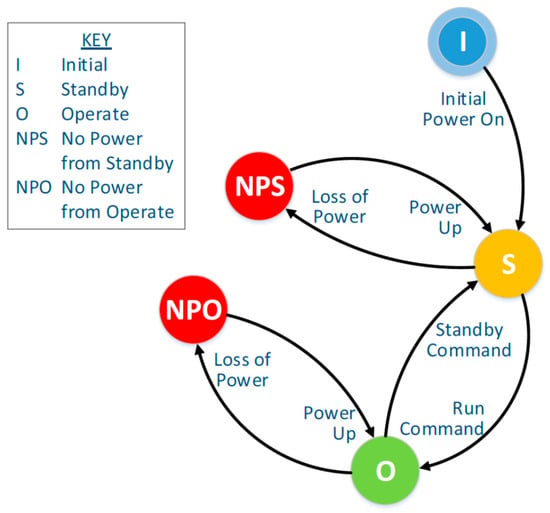
Figure 6.
RSU State Diagram [28].

Table 4.
RSU’s Operational States and State Transitions [28].
4. Age Replacement Models
The age replacement model is a reliability-based method used in the manufacturing industry on decisions related to the time to replace model parts and elements by consideration of the repair, replacement, and failure costs [29,30]. The age replacement model is very suitable for the RSUs and traffic signal elements. One of the very few applications of this concept to transportation infrastructure elements was shown in Sobanjo [31].
The methodology has two basic cases of application, in terms of what is done to the element before its failure: Case I—no repairs before replacement; and Case II—minimal repairs before replacement. Under Case I, the element, for example, a light bulb, needs to be replaced when it fails; it cannot be repaired. For Case II, there are some elements, such as gear bearings, that can be given some minimal repairs at early signs of malfunctioning, and these do not necessarily need to be replaced in early use. Both cases are described in Sobanjo [31] for bridge elements, but this paper will focus on Case I because it is assumed that a CAV’s RSUs will simply need to be replaced immediately when they stop functioning. The goal of the proposed method is to consider the failure consequences and identify an optimal age to at which the element can be best replaced, regardless of its condition.
Let cR and cF denote the estimated replacement cost and failure cost, respectively, for the CAV element. If the element is replaced before actual failure, the only cost incurred is cR; but if the failure occurs before replacement, both the costs, cR and cF, are incurred. Since some elements may fail and will be replaced before the age to do so, the total costs will vary among the elements. If cT represents the total cost for the element, then a policy, Z(to), can be defined for long-term average yearly cost for a replacement age, to, based on minimizing an objective function, given as the ratio of the expected total cost, to the expected time to failure. In other words,
Based on the probability of failure, at the age to, and the associated failure cost, cF, the expected total cost can also be given as:
The expected time to failure or replacement, shown as the denominator of Equation (1), is the probability of the element “surviving” to time to; this can be estimated as the survivor function, i.e.,
The objective function of the policy can be shown through a revision of Equation (1), as minimizing the average long-run cost,
The solution of minimizing Equation (4) is obtained by taking its derivative and setting to zero, i.e.,
If the rate of failure or hazard function at the replacement time, h(to), is defined as:
Then, the solution to can be expressed as follows:
Numerical Illustration
The adoption of Weibull distribution has been considered as being very suitable for modeling deterioration of elements with increasing failure rates (IFR) relative to age. The Weibull is very versatile in that, by virtue of the shape and scale parameter values, it can model different types of distributions. There are no recorded data on the failure times of CAV elements, so it will be assumed that CAV elements will behave close to those of elements with exponential time distributions, though it should be noted that exponential times do indicate an IFR. For exponential distributions, the Weibull distribution will indicate a shape factor (β) of 1.0 and a scale parameter (α) that is equivalent to the mean life of the element. As stated previously in this paper, the mean life of RSUs is stated as 100,000 hours, translating to 11.4 years. It would, therefore, be reasonable to adopt a Weibull distribution with a scale parameter (α) = 11.4, and a shape factor (β) just a few values greater than 1.0. In this study, the following values of β were investigated: 1.5, 1.6, 1.7, 1.8, 1.9, and 2.0, first starting with shape factor (β) = 1.5. The failure function (Equation (8) below), is shown in Figure 7. For Weibull distributions,
and:
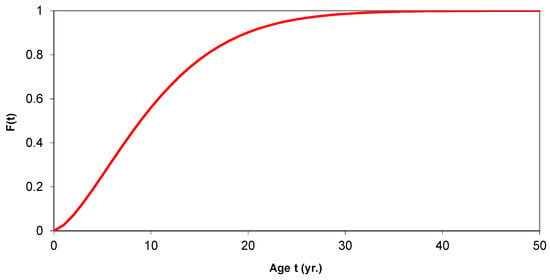
Figure 7.
Cumulative distribution function for CAV element deterioration.
Substituting the Weibull parameters, the expected service life of this CAV element is given as , or estimated using numerical approximations to be 9.8 years. Based on earlier discussions on the costs associated with CAV elements, if the element replacement cost is $45,000 and the failure cost associated with it is $100,000, then the ratio cR/cF is $45,000/$100,000, or 0.45. For the Case I scenario, as described earlier, when no repairs are done before replacement, the optimal solution becomes:
Substituting the Weibull parameters and cost ratios into the solution, the optimal age t0 is given as:
Using numerical approximation to estimate the integral term, the value of t0 is obtained to be 10.2 years, as the approximation is graphically indicated in Figure 8. This can be interpreted as a policy that whenever the CAV element fails before 10.2 years of service, it should be replaced but also that when it reaches 10.2 years of service, there must be a plan in place to replace it, regardless of its condition.
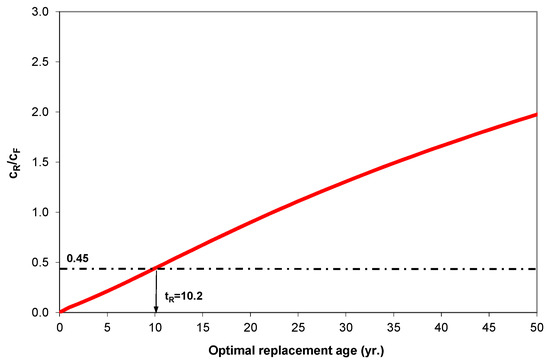
Figure 8.
Age replacement policy based for replacement/failure cost ratio = 0.45.
For the other failure cost situation, i.e., when failure (crash) cost = $150,000, and the replacement/failure cost ratio = 0.30, the result is shown in Figure 9 as t0 = 6.9 years. A similar interpretation applies here also, except that there is more urgency in the policy; given the magnitude of the failure consequences, there must be a plan in place to replace the CAV elements after just seven years of operation.
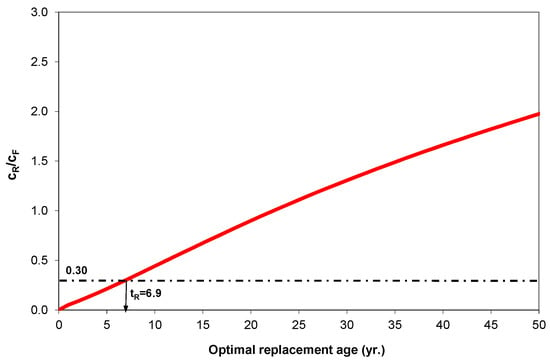
Figure 9.
Age replacement policy based for replacement/failure cost ratio = 0.30.
For the situation when failure cost equals $100,000, a sensitivity analysis was conducted by varying the shape factor (β) of the assumed Weibull distribution; the results are shown in Figure 10. With the factory-listed life of 11.4 years for the CAV units, and given the range of possible shape factors, it can be observed that for cR/cF ratios above 1.0, the units may not need to be replaced before the listed time of 11.4 years. But for the cR/cF ratios lower than about 0.5, it is recommended that the units be scheduled to be replaced prior to this listed lifetime. So, if the CAV units cost about the same at the various roadway locations, it is implied that at those locations very prone to costly crashes, the cR/cF ratios will be low, thus needing early scheduling of unit replacements. On the other hand, lesser crash-vulnerable locations (in terms of costs), may be handled with less urgency.
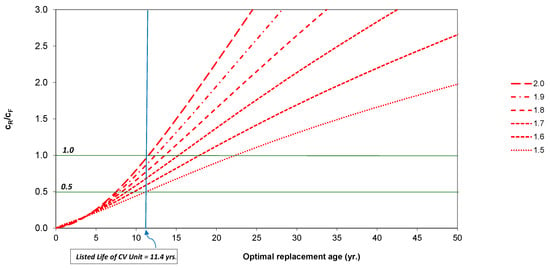
Figure 10.
Sensitivity of replacement/failure cost ratio to Weibull shape factor.
5. Other CAV Considerations
Apart from the focus on the optimal age to replace CAV units in order to avoid failure, there are other areas of related interests concerning the effects of CAVs on the civil infrastructures. One is the assessment of natural hazards on civil infrastructures with CAV elements, and the other is on the estimation of user costs associated with civil infrastructures. The following discussions present the two concepts and anticipates future research and implementation when historical and pertinent data become available from CAV implementation.
5.1. Vulnerability to Natural Hazards
Based on various studies reported for vulnerability of roadway and bridges to natural hazards, infrastructure elements, such as signs, poles, street lights, and movable bridge mechanical/electrical elements, including navigational lights and the operator facility, are particularly very vulnerable to damages due to hurricanes, flooding, and strong winds, such as tornadoes [32]. In a study on the damages to Florida’s state-maintained bridges due to Hurricanes Katrina, Frances, Rita, Wilma, Jeanne, and Charley, it was observed that 620 of about the 990 bridge elements damaged were signs, traffic signals, street lights, and movable bridge non-structural elements [32]. These elements are very similar to CAV elements. Padgett et al. [33] had also indicated a considerable amount of bridge damage were attributed to storm surge resulting in the submersion of mechanical and electrical equipment on movable bridges. These observations therefore suggest that RSUs and traffic signals need to be seriously protected and monitored in the environments where there is exposure to such natural hazards.
The reliability data for the failure of the CAV elements, as just as described above for the age replacement models, can be incorporated into the data for modeling the occurrence of natural hazards, such as hurricanes. The survivor functions of these two events (the conventional failure and the probable failure in the presence of hurricanes), can be combined to produce a resultant survivor function which can be used to predict the performance of the CAV elements. It is assumed here that the hurricane will be of such strength that it will completely damage the CAV elements. Hurricanes, as well as other hazards, such as earthquakes, etc., can be modeled as a Poisson process in terms of arrival of the events, say, with an average annual occurrence rate of 1. The hazard function for the failure of the CAV element under normal conditions was given earlier in Equation (10), but slightly revised here as follows:
The times between the occurrences of the hurricanes will be exponentially-distributed and the hazard function, which is a constant, can be stated simply:
Combining the hazard rates,
The resulting survivor function can be expressed as:
A study on the Florida bridges’ exposure to hurricane risks by Sobanjo and Thompson [32] estimated that the average of annual rate of the occurrence of Hurricane Category I at bridge locations as 0.064. Using the Weibull parameters used above for the numerical illustration of the age replacement models of the CV Unit, i.e., scale parameter (α) = 11.4, and a shape factor (β) = 1.5, the combined survivor function can be rewritten as shown below, and also in Figure 11.
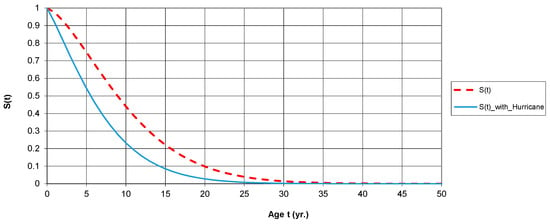
Figure 11.
Survivor curves of CAV elements in the presence of a hurricane hazard.
It should be noted here that there are some limitations in these results as there are possible correlations between the effects of the two events on the failure of the CAV elements. But in simple terms, Figure 11 implies that after 10 years in service, the CAV elements exposed to hurricanes will have a probability of about 25% of still in service, while those not in hurricane areas have a better chance, i.e., of about 45% probability, of being in service.
5.2. User Costs Considerations
In the economic evaluation of an existing infrastructure or any proposed improvement, user costs (different from the cost to physically construct the facility) are typically estimated and used as a criterion. The user cost consist of three components: value of the person’s time (delay); operating costs of vehicles; and costs associated with traffic accidents or crashes. User costs are incorporated into life cycle costs of roadways due to construction work zones, and user costs are also estimated in bridge rehabilitation and replacement considerations on infrastructure with functional deficiencies (load carrying capacity, under clearance, over clearance, etc.). These applications involve estimates of the associated traffic delays and accident costs.
Thompson et al. [34], as well as several other literature, have described detailed methodologies for estimating user costs due to bridge functional deficiencies. Thompson et al. [34] established a regression-based model relating accident risk to explanatory variables summarized as follows: functional class of roadway on bridge (interstate, collectors, local, urban, rural, etc.); number of lanes on bridge, length of the bridge; approach alignment rating; width of roadway on the bridge; average daily traffic count; and condition rating of deck. Except for the average daily traffic, these factors are not directly influenced by the traffic flow parameters. On the other hand, user costs associated with vehicle operating costs and travel time delays depend heavily on the traffic flow.
Zhu and Levinson [35] reported the impact of the collapse of a major interstate on the traffic flow and associated user travel costs. Borchardt et al. [36] demonstrated through traffic simulation tools, the estimation of user costs at work zones by studying the impact of traffic capacity and associated delays due to reduced speeds in work zones. The vehicle operating costs are also related to these additional time of travel. Since the CAV technology is expected to increase mobility and improve safety on the roadways, the reduced congestion and reduced crashes should lower the user costs associated with roadway infrastructure. With the introduction of CAVs into the traffic, it is hypothesized that since human judgment, which is attributed to most accidents, will be eliminated so that the number of accidents will be reduced. Qian and Yang [37] described research on feasible traffic flow models that would incorporate regular vehicles and AVs. But a note of caution is by OECD [38], which summarized that theory of eliminating significant accident risk by introduction of CAVs is not yet proven and that, with the partial automation levels, the risk due to driver’s judgement is still present.
It is also expected that with CAVs being able to drive closer and move at reduced vehicle headways or gaps, even at fast speeds, a higher traffic capacity can be achieved. The capacity, or the maximum traffic flow attainable on a roadway segment, is inversely related to the headway or gaps between the vehicles.
So, it may imply that with CAVs in the traffic stream, user costs estimates may be become lower, thus reducing the associated benefits for proposed improvements to the infrastructure. But it should be also noted that having a traffic stream with 100% CAV will not be a reality for some time, i.e., there will be a mixed traffic of conventional vehicles and CAVs. It will, therefore, be reasonable to modify user cost calculations by considering varied percentages of CAVs in the traffic, commonly termed as the CAV market penetration rates. Of significant benefit to user cost computations is the traffic microsimulation model, which incorporates the individual vehicle’s different behavior, as well as the interactions between the vehicles. Thus CAV characteristics can be incorporated in the simulation models to observe the resulting performance and expected impacts on the traffic stream. FHWA [39] lists popular traffic microsimulation software, including CORSIM, VISSIM, SimTraffic, AIMSUN, PARAMICS, Dynasim, and Transmodeler. The AIMSUM software (Advanced Interactive Microscopic Simulator for Urban and Non-Urban Networks) can be applied to calculate the user delay cost based on the different traffic volumes. Though relatively dated, Gettman and Head [40] also described methods of estimating safety consequences from the traffic simulation results. Sanusi and Sobanjo [41] and Sanusi [42] demonstrated, using the VISSIM simulation tool, the potential benefits of the CAV integration in terms of reduced travel times and safety.
There are also other various traffic simulation studies investigating the effects of varied market penetration rates of CAVs. Atkins [43], in an executive document, indicated the promising benefits of CAVs in the traffic flow in terms of more capacity but that this is not achieved at low penetration rates of the CAVs. Using a traffic simulation software, the same authors presented a more detailed study, with the penetration rates modified with CAV levels of automation, to observe CAVs leading to increased capacities, reduced network delays, and reduced delays at intersection, as well as reduced travel times on freeways segments [44]; these benefits were achieved only at 50% CAV penetrations rates and higher. OECD [38] summarized that the theory of eliminating significant accident risk by introduction of CAVs is not yet proven and that, with the partial automation levels, the risk due to a driver’s judgement is still present.
6. Conclusions
This paper presented an introduction to the concept of CAVs, with emphasis on the V2I, the infrastructure requirements, and the approach to the management of transportation assets involved. It appears that the major changes will be the installation of RSUs, which are non-structural assets, similar to the traffic signals, and mechanical/electrical elements on movable bridges. Most of the impacts would be at roadway intersections. A suitable approach to the condition assessment and deterioration modeling of these elements would be the application of reliability-based models, such as the age replacement models, where failure times are considered. Vulnerability of the elements is also of concern, as these type of elements are known to be the first ones to get damaged in natural hazards, such as hurricanes, tornadoes, and flooding. Reliability-based models can also be applied to model these combined events. In the future, when the CAV units have been deployed, the collection and analyses of failure times’ data will help to refine the models demonstrated in this paper.
Finally, regarding the issue of user costs, the CAV concept is expected to increase mobility and reduce roadway crashes, thus influencing the estimation of user costs. But more research is still needed, particularly, through traffic simulation, to ascertain the effects of the various percentages of CAVs in the traffic on the user costs.
Funding
This research received no external funding.
Conflicts of Interest
The author declares no conflict of interest.
References
- USDOT. Connected Vehicle Basics. U.S. Department of Transportation’s (USDOT); 2018. Available online: https://www.its.dot.gov/cv_basics/ (accessed on 31 January 2018).
- NHTSA. Automated Driving Systems 2.0: A Vision for Safety. U.S. Department of Transportation (USDOT) and the National Highway Traffic Safety Administration (NHTSA), 12 September 2017. Available online: https://www.nhtsa.gov/press-releases/us-dot-releases-new-automated-driving-systems-guidance (accessed on 31 January 2018).
- PCS. Planning for Connected and Automated Vehicles. Prepared by Public Sector Consultants (PSC), Lansing, Michigan, and Center for Automotive Research, Ann Arbor, Michigan, Prepared for Greater Ann Arbor Region Prosperity Region 9. March 2017. Available online: http://www.cargroup.org/wp-content/uploads/2017/03/Planning-for-Connected-and-Automated-Vehicles-Report.pdf (accessed on 31 January 2018).
- SEMA. NHTSA, SAE Define 5 Levels of Vehicle Automation. Specialty Equipment Market Association (SEMA), eNews Volume 20, No. 11. 16 March 2017. Available online: https://www.sema.org/sema-enews/2017/11/ettn-tech-alert-nhtsa-sae-define-5-levels-of-vehicle-automation (accessed on 30 January 2018).
- Chang, J. An Overview of USDOT Connected Vehicle Roadside Unit Research Activities. Publication Number: FHWA JPO-17-433. Published May 2017. Available online: www.its.dot.gov/index.htm (accessed on 30 November 2017).
- Wright, J.; Garrett, J.K.; Hill, C.J.; Krueger, G.D.; Evans, J.H.; Andrews, S.; Wilson, C.K.; Rajbhandari, R.; Burkhard, B. National Connected Vehicle Field Infrastructure Footprint Analysis. American Association of State Highway and Transportation Officials. Technical Report No. FHWA-JPO-14-125; United States. Dept. of Transportation. ITS Joint Program Office, 27 June 2014; 235p. Available online: https://rosap.ntl.bts.gov/view/dot/3440 (accessed on 30 January 2018).
- Waldrop, M.M. No Drivers Required. Nature 2015, 518, 20–21. Available online: https://www.nature.com/news/polopoly_fs/1.16832!/menu/main/topColumns/topLeftColumn/pdf/518020a.pdf (accessed on 30 January 2018). [CrossRef] [PubMed]
- NHTSA. U.S. DOT Advances Deployment of Connected Vehicle Technology to Prevent Hundreds of Thousands of Crashes; National Highway Traffic Safety Administration (NHTSA): Washington, DC, USA, Published 13 December 2016. Available online: https://www.nhtsa.gov/press-releases/us-dot-advances-deployment-connected-vehicle-technology-prevent-hundreds-thousands (accessed on 22 January 2018).
- Hedlund, J. Autonomous Vehicles Meet Human Drivers: Traffic Safety Issues for States; Prepared for Governors Highway Safety Association: Washington, DC, USA, February 2017; 26p, Available online: https://www.ghsa.org/sites/default/files/2017-01/AV%202017%20-%20FINAL.pdf (accessed on 29 July 2019).
- General Motors. Self-Driving Safety Report: Creating New Technology to Bring New Benefits. 2018. Available online: https://www.gm.com/content/dam/company/docs/us/en/gmcom/gmsafetyreport.pdf (accessed on 29 July 2019).
- Cheon, S. An overview of Automated Highway Systems (AHS) and the Social and Institutional Challenges They Face. UC Berkeley Faculty Publications. 2003. Available online: https://escholarship.org/content/qt8j86h0cj/qt8j86h0cj.pdf (accessed on 30 November 2017).
- Zhang, Y. Adapting Infrastructure for Automated Driving; Technical Report. Prepared for Tampa Hillsborough Expressway Authority; Department of Civil and Environmental Engineering, University of South Florida: Tampa, FL, USA, November 2013; 15p. [Google Scholar]
- GAO. Vehicle-to-Infrastructure Technologies Expected to Offer Benefits, but Deployment Challenges Existing Intelligent Transportation Systems. Government Accountability Office (GAO); Published September 2015. Available online: https://www.gao.gov/assets/680/672548.pdf (accessed on 31 December 2017).
- Tampa. Connected Vehicle Demonstration, Tampa Connected Vehicle Pilot. Tampa Hillsborough Expressway Authority. Available online: https://www.tampacvpilot.com/media-resources/photos/ (accessed on 15 July 2018).
- Barbaresso, J.C.; Johnson, P. Connected Vehicle Infrastructure Deployment Considerations: Lessons Learned from the Safety Pilot Model Deployment; Report Contract No. DTFH61-11-C-00040; HNTB Corporation, for University of Michigan Transportation Research Institute: Ann Arbor, MI, USA, 30 May 2014; 49p. [Google Scholar]
- FHWA. Freeway Management and Operations Handbook. Federal Highway Administration, United States Department of Transportation. Available online: https://ops.fhwa.dot.gov/freewaymgmt/publications/frwy_mgmt_handbook/chapter15_01.htm (accessed on 20 May 2018).
- USDOT. V2I Deployment Coalition. Technical Memorandum 4: Phase 1 Final Report. Published January 2017; 174p. Available online: https://transportationops.org/V2I/V2I-overview (accessed on 30 January 2018).
- Markow, M.J. Managing Selected Transportation Assets: Signals, Lighting, Signs, Pavement Markings, Culverts, and Sidewalks; NCHRP Synthesis 371; A Synthesis of Highway Practice, Transportation Research Board: Washington, DC, USA, 2007; 199p, ISBN 978-0-309-09789-5. [Google Scholar]
- FHWA. Transportation Asset Management Case Studies (Economics in Asset Management): The Hillsborough County, Florida, Experience. United States Department of Transportation, Federal Highway Administration, Office of Asset Management, May 2005; 24p. Available online: https://www.fhwa.dot.gov/infrastructure/asstmgmt/difl.pdf (accessed on 30 January 2018).
- Sobanjo, J.; Thompson, P. Enhancement of the FDOT’s Project Level and Network Level Bridge Management Analysis Tools; Final Report, Research Contract No. BDK83 977-01; Florida Department of Transportation: Tallahassee, FL, USA, 2011; 329p. Available online: https://rosap.ntl.bts.gov/view/dot/18692 (accessed on 30 January 2018).
- US DOT. Knowledge Resources: ITS Costs Database. Intelligent Transportation Systems Joint Program Office. Department of Transportation (U.S. DOT). Available online: https://www.itscosts.its.dot.gov/its/benecost.nsf/CostHome (accessed on 15 November 2018).
- Perez, S. Tampa Offers First Demo of its Connected Vehicle Technology Project, Launching with 1,600 cars in 2018. Available online: https://techcrunch.com/2017/11/13/tampa-offers-first-demo-of-its-connected-vehicle-technology-project-launching-with-1600-cars-in-2018/ (accessed on 15 November 2018).
- Jones, J.L. Autonomous Vehicle Report; Florida Highway Safety and Motor Vehicles: Tallahassee, FL, USA, 10 February 2014; 7p. [Google Scholar]
- Gordon, R.; Cade, B. Traffic Signal Operations and Maintenance Staffing Guidelines. Prepared by Dunn Engineering Associates, P.C. in cooperation with Kittelson and Associates, Inc. Prepared for Federal Highway Administration Washington, DC, USA; March 2009; 84p. Available online: https://ops.fhwa.dot.gov/publications/fhwahop09006/fhwahop09006.pdf (accessed on 15 November 2018).
- Harmon, T.; Geni, B.; Frank, G. Crash Costs for Highway Safety Analysis. Report No. FHWA-SA-17-071, Contract or Grant No. DTFH61-16-D-00005 (VHB); Federal Highway Administration Office of Safety: Washington, DC, USA, January 2018; 120p. Available online: https://safety.fhwa.dot.gov/hsip/docs/fhwasa17071.pdf (accessed on 15 November 2018).
- Dong, C.; Shao, C.; Li, J.; Xiong, Z. An Improved Deep Learning Model for Traffic Crash Prediction. J. Adv. Transp. 2018, 2018, 3869106. [Google Scholar] [CrossRef]
- BLS. Consumer Price Index. Bureau of Labor Statistics (BLS). US Department of Labor. Available online: https://www.bls.gov/cpi/ (accessed on 12 April 2019).
- FHWA. DSRC Roadside Unit (RSU) Specifications. Document v4.1, Federal Highway Administration (FHWA)’s Technical Support and tasks for Saxton Transportation Operations Laboratory. Project Number: DTFH61-12-D-00020; 31 October 2016. Available online: http://www.fdot.gov/traffic/Doc_Library/PDF/USDOT%20RSU%20Specification%204%201_Final_R1.pdf (accessed on 28 February 2018).
- Feldman, R.M.; Valdez-Flores, C. Applied Probability and Stochastic Processes; PWS Publishing Company: Boston, MA, USA, 1996; ISBN-13: 978-1-4822-5765-6. [Google Scholar]
- Datla, S.V.; Pandey, M.D. Estimation of life expectancy of wood poles in electrical distribution networks. Struct. Saf. 2006, 28, 304–319. [Google Scholar] [CrossRef]
- Sobanjo, J. Estimating the Timing of Rehabilitation and Replacement of Bridge Elements. In Journal of Transportation Research Board (TRB); No. 2220; Transportation Research Board of the National Academies: Washington, DC, USA, 2011; pp. 48–56. [Google Scholar]
- Sobanjo, J.O.; Thompson, P.D. Development of Risk Models for Florida’s Bridge Management System; Final Report, Research Contract No. BDK83 977-11; Florida Department of Transportation: Tallahassee, FL, USA, 2013; 298p, Available online: https://trid.trb.org/view/1254052 (accessed on 15 May 2018).
- Padgett, J.; DesRoches, R.; Nielson, B.; Yashinsky, M.; Kwon, O.-S.; Burdette, N.; Tavera, E. Bridge Damage and Repair Costs from Hurricane Katrina. ASCE J. Bridge Eng. 2008, 13, 6–14. [Google Scholar] [CrossRef]
- Thompson, P.; Najafi, F.T.; Soares, R.; Choung, H.J. Florida DOT Pontis User Cost Study. Final Report; Florida Department of Transportation: Tallahassee, FL, USA, 1999; 49p, Available online: www.pdth.com/images/fdotuser.pdf (accessed on 15 May 2018).
- Zhu, S.; Levinson, D. Traffic Flow and Road User Impacts of the Collapse of the I35W Bridge over the Mississippi River. Technical Report No. MN/RC 2010-21. Minnesota Department of Transportation, July 2010. Available online: https://www.lrrb.org/pdf/201021.pdf (accessed on 1 August 2019).
- Borchardt, D.W.; Pesti, G.; Sun, D.; Ding, L. Capacity and Road User Cost Analysis of Selected Freeway Work Zones in Texas. Technical Report No. FHWA/TX-09/0-5619-1. Texas Department of Transportation and Federal highway Administration, September 2009. Available online: https://static.tti.tamu.edu/tti.tamu.edu/documents/0-5619-1.pdf (accessed on 15 May 2018).
- Qian, S.; Yang, S. What do Autonomous Vehicles Mean to Traffic Congestion and Crash? Network Traffic Flow Modeling and Simulation for Autonomous Vehicles. Final Report. Contract No. DTRT12GUTG11. Technologies for Safe & Efficient Transportation. The National USDOT University Transportation Center for Safety. Carnegie Mellon University. University of Pittsburg. Available online: https://pdfs.semanticscholar.org/0bcd/45bbd12059d85a07bba4221fe900664994a8.pdf (accessed on 29 July 2019).
- OECD. Safer Roads with Automated Vehicles? Report from International Transport Forum’s Corporate Partnership Board. Available online: https://www.itf-oecd.org/sites/default/files/docs/safer-roads-automated-vehicles.pdf (accessed on 15 May 2018).
- FHWA. Analysis, Modeling, and Simulation for Traffic Incident Management Applications Synthesis of Incident Analysis, Modeling, and Simulation Methods. The Federal Highway Administration’s (FHWA) Office of Operations. Available online: https://ops.fhwa.dot.gov/publications/fhwahop12045/2_synth.htm (accessed on 12 June 2018).
- Gettman, D.; Head, L. Surrogate Safety Measures from Traffic Simulation Models; Final Report, Publication No. FHWA-RD-03-050; Office of Safety Research and Development, Turner-Fairbank Highway Research Center, Federal Highway Administration: McLean, VA, USA, 2003; 126p. Available online: https://www.fhwa.dot.gov/publications/research/safety/03050/03050.pdf (accessed on 12 June 2018).
- Sanusi, F.; John, O.S. Assessment of Potential Impacts of Connected Autonomous Vehicles on Mobility and Conflicts in a Work Zone: A Microsimulation Based Approach. Poster presentation, Florida Automated Vehicles Summit 2017, Tampa, FL, USA. November 2017. Available online: https://favsummit.com/2017-fav-student-poster-competition-winners/ (accessed on 12 June 2018).
- Sanusi, F. Modeling Connected and Autonomous Vehicles Impacts on Mobility and Safety in Work Zones. Master’s Thesis, Florida State University, Tallahassee, FL, USA, July 2018; 109p. Available online: https://fsu.digital.flvc.org/islandora/object/fsu%3A647295 (accessed on 20 December 2018).
- ATKINS. Research on the Impacts of Connected and Autonomous Vehicles (CAVs) on Traffic Flow, Stage 1: Evidence Review. Technical Report; Department for Transport, March 2016; 40p. Available online: https://www.gov.uk/government/uploads/system/uploads/attachment_data/file/530092/impacts-of-connected-and-autonomous-vehicles-on-traffic-flow-evidence-review.pdf (accessed on 12 June 2018).
- ATKINS. Research on the Impacts of Connected and Autonomous Vehicles (CAVs) on Traffic Flow, Stage 2: Traffic Modelling and Analysis. Technical Report; Department for Transport, May 2016; 110p. Available online: https://www.gov.uk/government/uploads/system/uploads/attachment_data/file/530093/impacts-of-connected-and-autonomous-vehicles-on-traffic-flow-technical-report.pdf (accessed on 12 June 2018).
© 2019 by the author. Licensee MDPI, Basel, Switzerland. This article is an open access article distributed under the terms and conditions of the Creative Commons Attribution (CC BY) license (http://creativecommons.org/licenses/by/4.0/).